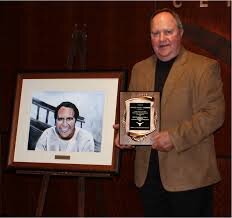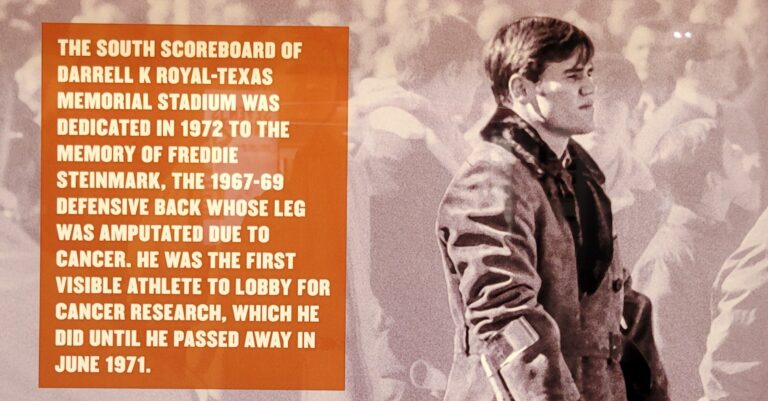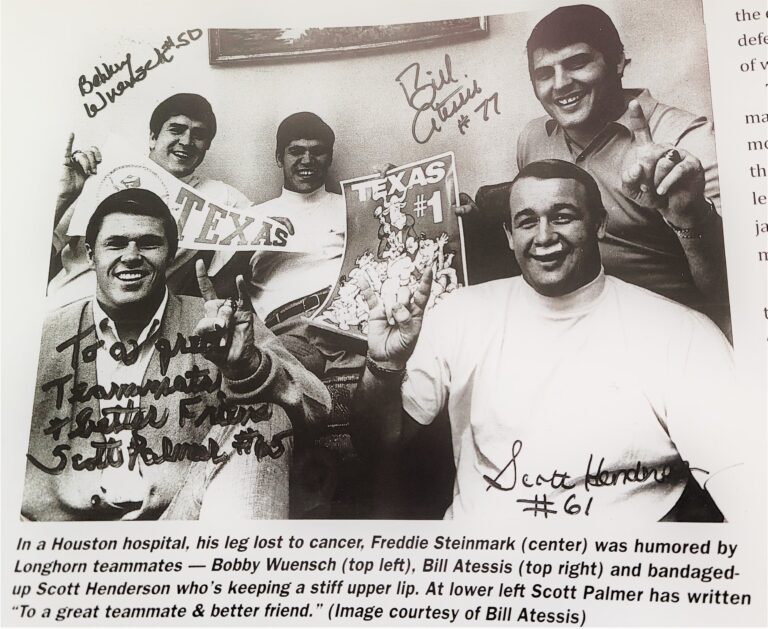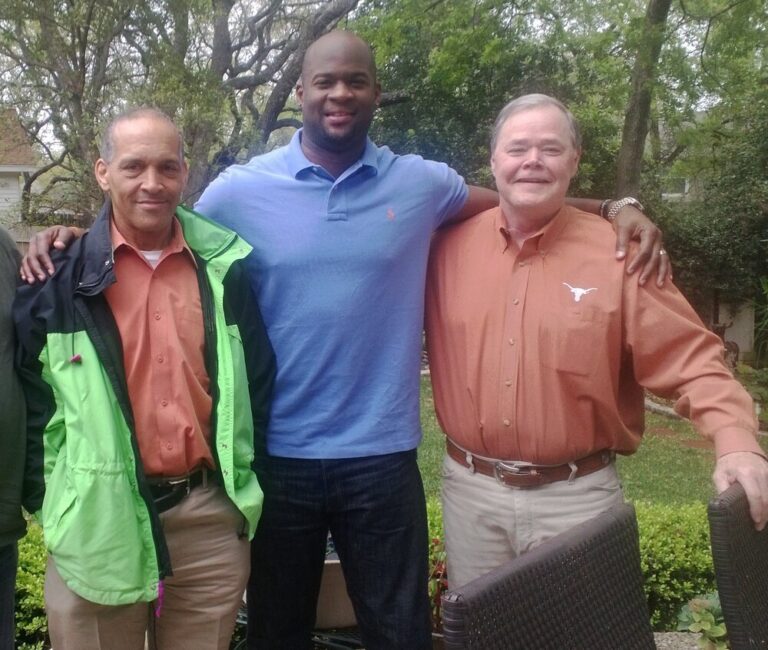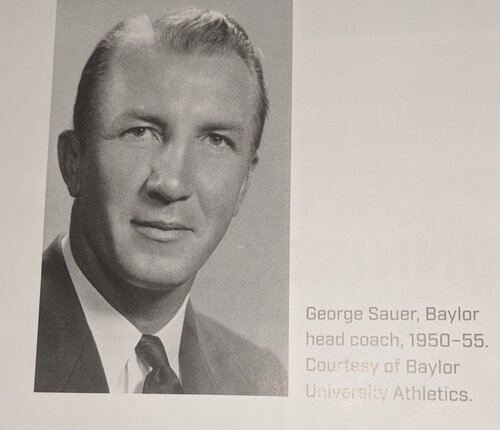Freddie Steinmark Lost too Soon
50 years after the Big Shootout, one Longhorn player said, “He felt a real spiritual bond among the Arkansas players. You could feel a lot of our players (Longhorns) had developed that same feeling. In some ways, it seemed like the Razorbacks were looking for what I had—a championship ring, and I was looking for what they had—spiritual understanding. “
In the book “Horns, Hogs and Nixon Coming”, the author Terry Frei interviews offensive guard Randy Stout. Randy had a final exam Tuesday morning so he got up at 5:00 AM took his books into the hallway Commons area in the back of one floor and started cramming.
Just before 7, Freddie Steinmark slipped out of his room wearing blue jeans and a T-shirt. Randy says, “Where are you going?” Freddie says, “My leg really hurts, so I am going to see the doctor for X-rays.” Doctor Joe Reneau was the team physician, and Doctor Julian was the specialist who interpreted the X-rays. Doctor Julian told Freddie, “Because of the spot on the film just above his left knee, he was being sent to MD Anderson Hospital Tumor Institute in Houston.”
Michael Stephens says :
Doctor Joe Reneau is truly one of the great team physicians that I had the pleasure to work with. I will never forget the day I took Freddie Steinmark to Joe Reneau’s office after the Arkansas game. He was honest and compassionate in his explanation of what Freddie might have done. He set up everything for him at M D Anderson, and Freddie and I had a great conversation about what was next for him on our way to the dorm to get his bag and clothes for the trip. As I put him on the private plane, he told me how much he loved Dr. Reneau and me for our help and honesty.
Doctor Charles A. LeMaistre, The University vice-chancellor, escorted Freddie to Houston on a leased jet. Royal got news of Freddie’s condition while he was in New York celebrating the national championship with the three Longhorn football Captains. After the banquet honoring the Longhorns was over, Royal got the news that Freddie’s prognosis wasn’t good and that a private jet would take him straight to Houston. Frank Medina broke the news to one of Steinmark’s closest friends, Henderson. Scott said, “I hadn’t seen Freddy in a couple to three days, but I didn’t think anything about it. All I know is he was having trouble with his leg.”
Great News – My All American is now on Netflix with a 5-star rating
Information about the life of Freddie Steinmark follows:
My All American Trailer
Author Ken Capps Texasfootball.com
November 12, 2015
by Ken Capps
The joyous and painful true story of former Texas Longhorns star Freddie Steinmark hits the big screen 44 years after his death, November 13, 2015.
CBS link below
Freddie’s recruitment would pay off as the Longhorns brought the wishbone to college football and began a 30-game winning streak, winning two national titles in the process. Steinmark was one of the key cogs on defense.
Tom Campbell, Randy Peschell, Billy Dale, Angelo Pizzo, ?, Mike Campbell, Stan Mauldin
Bottom row- Mike Campbell, Billy Dale
Top Row Bill Atessis, Corby Robertson, Don Burrisk, Bobby Wunesch
But the joy was short-lived, as Steinmark was diagnosed with bone cancer just after the “Game Of The Century” between Texas and Arkansas in 1969. Steinmark died 1971.
Freddie intercepts a Sooner pass in 1969 in the link below.
https://x.com/longhornclips/status/1883949344384283054?s=66&t=AisTN2mIwIXyJzIqdpQdiQ
www.fox7austin.com/good-day/14857833-story
http://www.freddiejoesteinmark.com/
“My All American” was written by Angelo Pizzo, the same screenwriter who penned “Rudy” and “Hoosiers.” The film is adapted from the new book “Courage Beyond The Game” by Texas writer Jim Dent, who’s best known for his books “The Junction Boys” and “Twelve Mighty Orphans.”
Pizzo spoke with TexasFootball.com in Dallas, explaining his motivation for the film.
Freddie steinmark’s far-reaching legacy still felt 54 years after death from osteosarcoma, former Texas national champion Freddie Steinmark’s immense impact on the battle against cancer is still readily evident.
click on link below “Ken Rodriguez”.
Ken Rodriguez
DEC 3, 2015
The black-and-white photo in the Alabama newspaper showed the handsome face of a University of Texas football player, awash in inexplicable joy. The story told of a malignant tumor, an amputation below the left knee, a cruel disease that put a star safety on crutches for the 1970 Cotton Bowl against Notre Dame. In the shadow of gloom, Freddie Steinmark glowed, inspiring his national champion teammates with a strong, radiant spirit.
From her kitchen table in Montgomery, Julia Alice Rice studied the Steinmark smile and story, a mysterious lump on her left ankle, swelling. The emerging details of Freddie’s osteosarcoma—bone cancer—gave her pause. A 30-year-old wife, mother, and librarian, Julia Alice considered the growth, symptoms, and pain in her own lower leg and wondered if she had the same disease.
The first diagnosis came back negative. A doctor removed a cyst, but the lump grew back. A second diagnosis, months later in 1971, revealed osteosarcoma. Surgeons needed to amputate but discovered a complication. Julia Alice was nine weeks pregnant.
The baby, doctors informed her, could not survive the operation. She needed to abort. “You can take my leg,” said Julia Alice, a devout Southern Baptist, “but you can’t take my baby.” Doctors persisted. Julia Alice resisted. In the heated back-and-forth, she learned a grim truth. Even without an abortion, she stood a one percent chance of surviving more than one year after the amputation.
Julia Alice had a husband, Norman Rice, a football coach in Montgomery, and a three-year-old son, Jim. Within a year, the former would become a widower, the latter motherless. Friends urged Julia Alice to abort.
Eight hundred miles away in Austin, Freddie Steinmark waged his own fight. A 5’9″, 160-pound safety out of Wheat Ridge, Col. Freddie had played the 1969 season with a tumor the size of a softball. After the amputation, he underwent chemotherapy while attending class and coaching defensive backs on UT’s freshman football team.

As the disease spread, Steinmark became the face of the American Cancer Society, giving motivational speeches across the country. He played golf on one leg, knocking drives 225 yards, and water skied. He played the piano and proposed to the girl he’d dated since eighth grade. Linda Wheeler said, “Yes.”
Despite a gallant fight, his condition grew grave. On June 6, 1971, he died.
That same month, surgeons removed Julia Alice’s left leg. Four months later, Geoff Rice was born. Julia Alice lived to see him walk, get married, and father a daughter—44 more years. Geoff turned 44 on Oct. 8. Just before Thanksgiving, he saw My All-American, the inspirational film about Steinmark. Scene after scene tugged at his heart. The one where doctors deliver the diagnosis pierced it. Geoff wept. “Freddie didn’t save one life,” he says. “He saved two.”
The legacy of Freddie Steinmark cannot be captured in a motion picture. It cannot be fully told in a book, and at least three have been written. He inspired President Nixon to declare War on Cancer. He moved Congress to pass the National Cancer Act. As a result, the National Cancer Institute, which had a budget of $200 million in 1971, received $1.5 billion for research over the next three years. That research changed lives, salvaged limbs, and healed bodies. “There are so many stories,” says Sammy Steinmark, Freddie’s younger brother, “I can’t count them all.”
*****
On his home TV in Rochester, Minn., 12-year-old Thomas Smith watched Freddie and No. 1 Texas rally to beat No. 2 Arkansas 15–14 on Dec. 6, 1969, a thriller known as “The Game of the Century.” Weeks later, Smith watched in astonishment as Freddie stood on the Cotton Bowl sidelines, bundled in a winter coat, propped on crutches, left leg missing.
The image stuck. It caused a young boy to think and connect desire with possibility. Even as a pre-teen, Smith imagined a career in medicine. He knew Rochester was the home of the Mayo Clinic. But what kind of doctor might he become? The answer appeared on TV. “The picture of Freddie in his trench coat with one leg at the Cotton Bowl,” Smith says, “always stayed with me.”
Smith graduated from Michigan State and attended Mayo Medical School, which is part of the Mayo Clinic, a leading cancer center for osteogenic sarcoma. Later, he pursued pediatric oncology. “There were many reasons why, including the satisfaction of helping people at their deepest time of need and the scientific advancements being made in pediatric oncology,” Smith says. “But I must admit, the idea of helping a young person like Freddie not only live but avoid amputation was a very important factor in my choice.”
If Freddie developed osteosarcoma today, doctors could probably save his leg and life. When Smith attended medical school in the 1980s, treatment began changing. Instead of amputating first, doctors started patients on chemotherapy. Then, they surgically removed cancerous tissue. As medical procedures advanced, surgeons replaced cancerous bone with titanium rods to save limbs.
New treatments have produced dramatic results. “We have a cure rate that approaches 80% and a need to amputate in only 10% of patients,” Smith says.
He has treated hundreds of young patients with osteogenic sarcoma and other bone cancers, some of them athletes. Smith often shares Freddie’s story. “I have many survivors, many of them in their 20s and 30s, starting their own families,” he says. “Freddie fought not only for himself but for other young people with OGS (osteogenic sarcoma). I think the survivors I see today are a direct result of Freddie’s persistence and determination. He has inspired me since I first saw him on the sideline in the Texas-Notre Dame game 45 years ago.”
*****
Julia Alice forgot Freddie’s name. Time caused that detail to disappear, but not his face or story. It seemed as if Freddie imparted his fierce, can-do spirit to a wife and mother in Alabama. Julia took her boys to the pool and swam with her prosthetic. She took Geoff to a skating party and strapped on a pair of roller skates. She left her job at the library, became a special education director, served as a church deacon, and cheered at her son’s ball games, sometimes on one leg, mostly on two.
“When I was young, I thought everyone’s mom had an artificial leg,” Geoff says. “After all, mine did, and in my mind, she was no different than any other mom.”
The family moved to Birmingham, and the boys grew up. Julia Alice shared bits and pieces about the Texas football player who saved two lives with little reaction. Jim and Geoff nodded and thought that was cool, then ran outside to play. Jim did not care to know more until his late 20s when curiosity drove him to the library. Who was this football player? What became of him? Jim brought a name and picture home to Mom. “Freddie Steinmark,” Julia Alice murmured. “That’s him.”
Jim returned to the library with an idea. He would gather more information on Freddie, research his mother’s journey, and surprise her with a book. He would contact the Steinmarks and tell them how Freddie had saved his mother and brother. An athletic ticket manager at Eastern Kentucky, Jim had a master’s in sports administration but regretted not majoring in journalism. Writing his mother’s story would be an adventure and satisfy a longing. Years passed. The plan stalled.
In 2013, Jim, now a marketer, told Julia Alice about the surprise that had not materialized. She suggested they collaborate. Jim resumed the research but suffered a stroke in January. After he recovered, Julia Alice fell ill. Before Jim could interview her, she was hospitalized with a rare lung disease unrelated to bone cancer. A non-smoker, Julia Alice died on Aug. 6, three months before the release of My All-American.
*****

In the south end zone of Darrell K. Royal-Texas Memorial Stadium, beneath a giant scoreboard dedicated to Freddie, 67-year-old Tom Campbell shakes his head, eyes turning moist.
Why me, Lord? Why did you take Freddie and not me?
Campbell played with Freddie. A defensive back who made game-saving interceptions against Arkansas and Notre Dame, Campbell has no answers after 44 years. Freddie studied hard, played hard, and didn’t drink. He went to Mass every morning. Whatever his flaws, they are not easily recalled.
My All-American screenwriter and director, Angelo Pizzo, was unable to incorporate sin into the story of a saint.
“I researched everything—talked to all the players, all the family,” Pizzo says, standing near Campbell during Texas-Kansas on Nov. 7. “And I couldn’t find anyone to tell me one bad thing about him.”
Twelve years ago, Campbell lost a sales job with Xerox. Shocked at the layoff—“I hadn’t done anything wrong,” he says—Campbell did not fall apart. He found another job and moved on. Freddie, he says, pulled him through. “I’ve had tough times my whole life,” Campbell says. “But I was prepared. There was never any quit in Freddie.”
Campbell and Pizzo are wearing Freddie’s orange and white No. 28 jersey. A host of family, friends and former teammates are, too. On this day, Texas is rededicating the scoreboard to Freddie, which was named for him in 1972. A few feet away stands Ted Koy, a running back who played with Freddie and later with O.J. Simpson in Buffalo. Koy is a recent prostate cancer survivor. He names a growing fraternity of former teammates who have beaten or are battling cancer. “My life was blessed,” Koy says, “because I knew Freddie Steinmark.”
A roar goes up. Texas safety Dylan Haines has intercepted a Kansas pass late in the first quarter. Haines sprints downfield, a flash of Freddie in the 36-yard return to the four-yard line.
Only Texas offered Freddie a scholarship. Nobody offered one to Haines at Lago Vista High, just north of Austin. No one thought he could even play Division II or NAIA football. The son of a former Longhorn defensive lineman (John) and hurdler (Sandra), Dylan walked on at Texas in 2012, never expecting to play a down. But he’d already had a brush with Freddie.
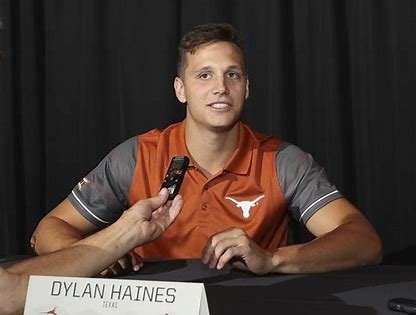
Dylan sprained an ankle his senior year and considered sitting out a game. Sandra found a magazine story about Freddie and stuck it in her son’s athletic bag. After reading the piece, Dylan suited up, played both ways, and scored a touchdown despite a pronounced limp. “I decided if this guy could play with cancer in his leg,” Dylan says, “I wasn’t going to let a sprained ankle keep me out.”
Three years after Dylan walked on at Texas, new coach Charlie Strong recognized a playmaker. Dylan earned a starting spot and a scholarship. Early in his first game last season, Dylan picked off a North Texas pass and heard his mother screaming. She hasn’t stopped. He intercepted three more passes in 2014, returning one for a touchdown, and leds the Longhorns with five picks this season.
*****
Sam Murphy used to play lacrosse and basketball for Valor Christian High in Highlands Ranch, Col., the same school Stanford running back Christian McCaffrey attended. Once, during practice, Murphy and McCaffrey jumped for a rebound. Murphy came down on the floor, and McCaffrey’s foot came down on Murphy’s head. The concussion Murphy sustained was minor compared to the diagnosis that followed the summer before his junior year: Ewing sarcoma in his right leg.
He underwent 12 weeks of chemotherapy, surgery to remove the tumor, and 24 more weeks of chemo. Reconstructive surgery on his leg came later. There’s no trace of cancer today. Thomas Smith considers Murphy, a University of Kansas freshman, a success story. Murphy, 19, has been cleared to play golf. He hopes to play intramural basketball in February.
As he battled bone cancer, Murphy learned about another young athlete from Colorado with a leg tumor: Freddie Steinmark. Murphy discovered he had friends who attended Freddie’s school, Wheat Ridge High. Now Murphy had someone with whom he could identify, a role model who could inspire him. “Freddie saved more than hundreds of lives,” Murphy says. “It’s more like thousands. Maybe millions. People get checked because of Freddie. He changed the way the medical community looked at cancer.”
Geoff Rice was an unremarkable athlete. Sam Murphy made the varsity lacrosse team as a freshman. Geoff saw reserve duty for the Homewood High (Ala.) baseball team as a senior. His career highlight was going 2 for 2 in one game at Birmingham’s Rickwood Field, the oldest professional ballpark in the U.S. Dizzy Dean pitched there. The Pittsburgh Pirates held spring training there. The Detroit Tigers, Kansas City Royals, and Chicago White Sox had Double-A teams that played there. Geoff Rice collected two singles in two at-bats there.
Geoff works in the claims department for an automobile insurance company in Birmingham. He and his wife and 14-year-old daughter live across the street from his brother, Jim. “It’s not that I’ve lived an incredible life or became a great athlete or rock star or movie star,” Geoff says, “but I have a family that loves me, and I love them.”
His mother and brother never got to write that book, and the family never got to tell the Steinmarks how Freddie had touched them. But not long ago, Geoff got to thinking: Maybe he could send a note to Bower Yousse, co-author of the biography “Freddie Steinmark: Faith, Family, Football.” Yousse wrote back, “I will gladly share your story with Freddie’s family.”
The stories keep finding their way to Sammy Steinmark. A pediatric oncologist in Denver. A lacrosse player in Richmond Heights. A walk-on at the University of Texas. Former Longhorns in Austin. A family in Birmingham. When Nixon declared war on cancer, he didn’t know the bravest soldier would still be fighting long after they were both gone.
